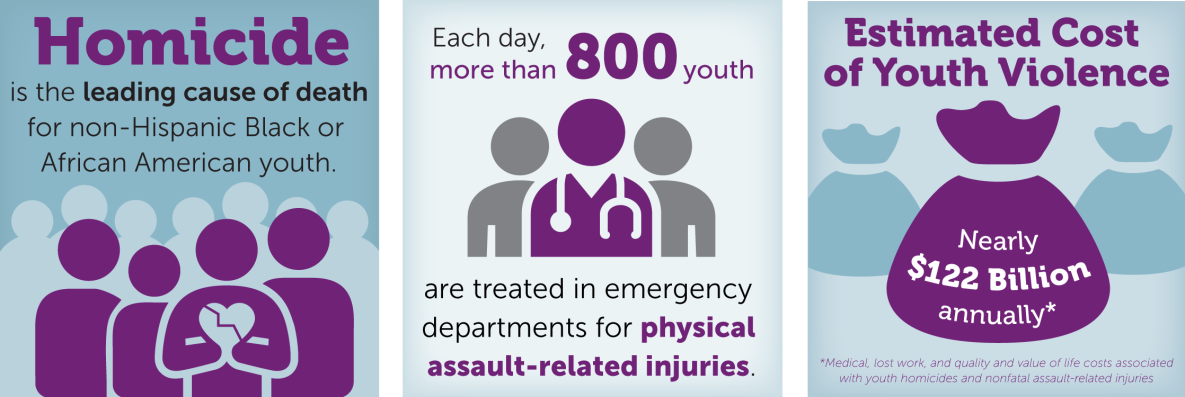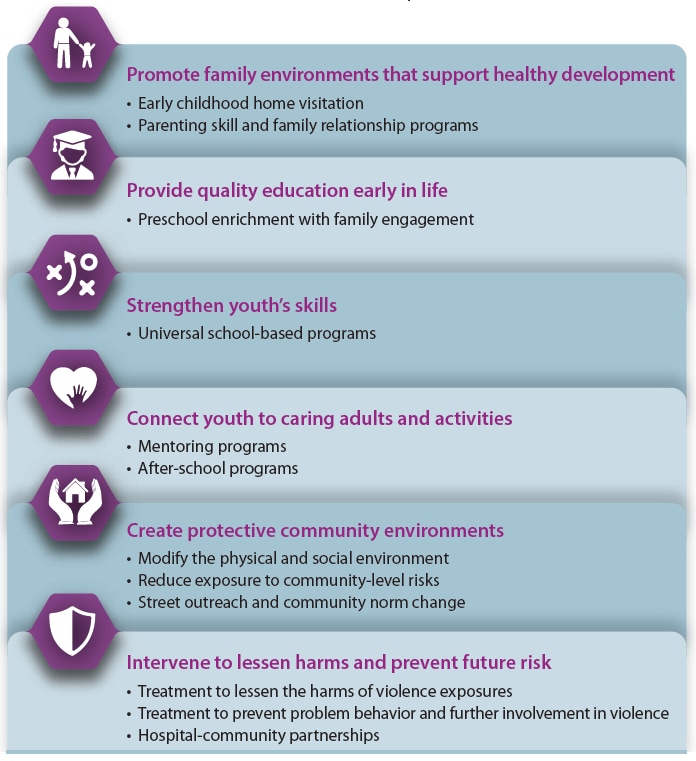Preventing Youth Violence

Youth violence is the intentional use of physical force or power to threaten or harm others by young people ages 10-24. It can include fighting, bullying, threats with weapons, and gang-related violence. A young person can be involved with youth violence as a victim, offender, or witness.
Youth violence is a serious public health problem. It is an adverse childhood experience (ACE) that can have long-term impacts on health and wellbeing. The good news is violence is preventable, and we can all help young people grow without violence.
Thousands of people experience youth violence every day. Youth violence negatively impacts youth in all communities—urban, suburban, rural, and tribal.
Youth violence is common. Homicide is the third leading cause of death for young people ages 10-24 and the leading cause of death for non-Hispanic Black or African American youth. Emergency departments treat over 800 young people for physical assault-related injuries each day.
Some youth are at greater risk than others.
- Sexual minority teens are more likely to experience multiple forms of violence compared to their heterosexual peers.
- Black or African American youth and young adults are at higher risk for the most physically harmful forms of violence (e.g., homicides, fights with injuries, aggravated assaults) compared with White youth and young adults.
Youth violence is costly. In 2020, youth homicides and nonfatal physical assault-related injuries resulted in an estimated $122 billion annually in costs including medical care, lost work, and quality of life. This estimate does not include costs to the criminal justice system.
COVID-19 has impacted the economic burden of youth violence. Compared to 2019, the economic burden of youth violence was 17% higher in 2020 ($122 billion vs. $105 billion).

Youth violence can have serious and lasting effects on young people’s physical, mental, and social health. It can harm development and contribute to impaired decision-making, learning challenges, decreased connections to peers and adults, and trouble coping with stress.
Youth violence is linked to negative health and well-being outcomes and disproportionately impacts communities of color. Violence increases the risk for behavioral and mental health difficulties. These can include future violence perpetration and victimization, smoking, substance use, obesity, high-risk sexual behavior, depression, academic difficulties, school dropout, and suicide.
Violence increases health care costs, decreases property value, negatively impacts school attendance, and decreases access to community support services. Addressing the short- and long-term consequences of violence strains community resources and limits the resources that states and communities can use to address other needs.
We can protect youth and support their growth into healthy adults. Certain factors may increase or decrease the risk of youth experiencing or perpetrating violence. To prevent youth violence, we must understand and address the factors that put people at risk for or protect them from violence.
CDC developed Youth Violence Prevention Resource for Action [4 MB, 64 Pages] to help communities use the best available evidence to prevent youth violence. This resource is available in English and Spanish [3.89 MB, 68 Pages]. It can impact individual behaviors and the relationship, family, school, community, and societal factors that influence risk and protective factors for violence.
Long-standing systemic health and social inequities have put many people from racial and ethnic minority groups at increased risk of violence. It is important for prevention efforts to consider societal conditions disproportionately experienced by Black or African American youth and young adults. This includes conditions like concentrated poverty, residential segregation, and other forms of racism that limit opportunities to grow up in healthy, violence-free environments. Addressing the root causes of violence is critical to reducing high rates of violence in communities of color.
All young people deserve to grow up safely and thrive. See Youth Violence Resources for publications, data sources and prevention resources for youth violence.
- David-Ferdon, C., Vivolo-Kantor, A. M., Dahlberg, L. L., Marshall, K. J., Rainford, N. & Hall, J. E. (2016). Youth Violence Prevention Resource for Action: A Compilation of the Best Available Evidence. Atlanta, GA: National Center for Injury Prevention and Control, Centers for Disease Control and Prevention. Note: The title of this document was changed in July 2023 to align with other Prevention Resources being developed by CDC’s Injury Center. The document was previously cited as “A Comprehensive Technical Package for the Prevention of Youth Violence and Associated Risk Behaviors.”
- David-Ferdon C, Clayton HB, Dahlberg LL, et al. Vital Signs: Prevalence of Multiple Forms of Violence and Increased Health Risk Behaviors and Conditions Among Youths — United States, 2019. MMWR Morb Mortal Wkly Rep 2021;70:167–173. DOI: http://dx.doi.org/10.15585/mmwr.mm7005a4
- Sheats KJ, Irving SM, Mercy JA, Simon TR, Crosby AE, Ford DC. Merrick MT, Annor FB, Morgan RE. (2018). Violence-Related Disparities Experienced by Black Youth and Young Adults: Opportunities for Prevention, American Journal of Preventive Medicine; 55(4): 462-469, https://doi.org/10.1016/j.amepre.2018.05.017
- Peterson C, Parker EM, D’Inverno AS, Haileyesus T. Economic Burden of US Youth Violence Injuries. JAMA Pediatr. Published online September 18, 2023. doi:10.1001/jamapediatrics.2023.3235.
